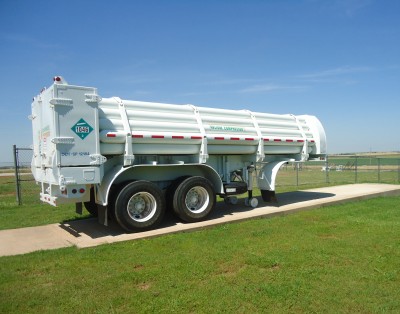What’s a Little Helium Among Friends?
Published: 28 June 2013

What is white and blue, can hold 55,000 standard cubic feet (scf) of gas, and looks like it could attach to the International Space Station? A helium storage system, of course.
This impressive contraption arrived at the ARM Southern Great Plains site in early June, along with 18,000 scf of helium inside—valuable stuff, considering the global helium shortage and high price tag. Thanks to ARM colleagues in New Mexico, site operations staff will use the helium in launching weather balloons for only the cost of transportation. How?
Share and Share Alike
Earilier this year, Jeff Zirzow and Fred Helsel, part of ARM’s North Slope of Alaska (NSA) operations team from Sandia National Laboratories, received the partially full helium trailer at no cost from another group at Sandia. They planned to fill it up and send it to Oliktok, Alaska, where a new ARM Mobile Facility will be deployed later this year.
However, the cylinder certifications had lapsed and the vendor in Houston would not accept them for retesting until emptied due to the risk of system contamination from the gas sitting in the tanks. So the NSA team had two options to consider before delivering the storage system for recertification: find someone to use the helium—the trailer and cylinders could still be trucked where needed; or vent the inert gas into the air—it is not toxic and poses no environmental or health risks.
Rather than see the valuable gas go to waste, Zirzow called ARM colleague Doug Sisterson, a research meteorologist at Argonne National Laboratory and manager for the Southern Great Plains site. Since 1994, daily weather balloon launches have been part of the site’s comprehensive observatory that obtains critical, long-term atmospheric data for weather and climate research.
After discussing their options, Sisterson contacted the SGP’s on-site operations manager, John Schatz. As a resident of nearby Billings, Oklahoma, and a 20-year veteran with the SGP site, Schatz is well-respected within the community and among the local vendors that provide products and services to the site. He explained the unexpected windfall to their local helium vendor, along with the plan that would most benefit taxpayers: avoid waste and save money by using the available helium at the SGP site.
With excellent teamwork among the DOE labs and the cooperation of SGP site partners, the plan was set in motion. Sandia paid to have the truck driven to the SGP site. With nearly four months worth of helium to fill their weather balloons, Argonne will then pay drivers to take the empty storage trailer to Houston. Sandia will then pay for the recertification and transport back to Sandia, where the system will be refilled and readied for its new home in Alaska.
The ARM Climate Research Facility is a DOE Office of Science user facility. The ARM Facility is operated by nine DOE national laboratories, including .
Keep up with the Atmospheric Observer
Updates on ARM news, events, and opportunities delivered to your inbox
ARM User Profile
ARM welcomes users from all institutions and nations. A free ARM user account is needed to access ARM data.


















